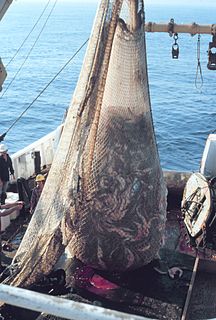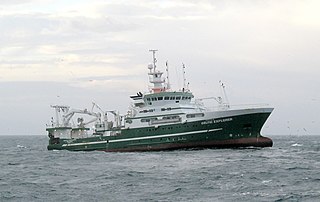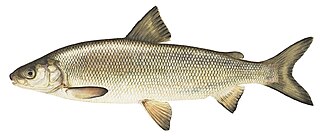| Look up groundfish in Wiktionary, the free dictionary. |
Groundfish are fish that live on, in, or near the bottom of the body of water they inhabit. Some typical saltwater groundfish species are cod, [1] flounder, halibut, and sole.

Fish are gill-bearing aquatic craniate animals that lack limbs with digits. They form a sister group to the tunicates, together forming the olfactores. Included in this definition are the living hagfish, lampreys, and cartilaginous and bony fish as well as various extinct related groups. Tetrapods emerged within lobe-finned fishes, so cladistically they are fish as well. However, traditionally fish are rendered paraphyletic by excluding the tetrapods. Because in this manner the term "fish" is defined negatively as a paraphyletic group, it is not considered a formal taxonomic grouping in systematic biology, unless it is used in the cladistic sense, including tetrapods. The traditional term pisces is considered a typological, but not a phylogenetic classification.

Seawater, or salt water, is water from a sea or ocean. On average, seawater in the world's oceans has a salinity of about 3.5%. This means that every kilogram of seawater has approximately 35 grams (1.2 oz) of dissolved salts. Average density at the surface is 1.025 kg/L. Seawater is denser than both fresh water and pure water because the dissolved salts increase the mass by a larger proportion than the volume. The freezing point of seawater decreases as salt concentration increases. At typical salinity, it freezes at about −2 °C (28 °F). The coldest seawater ever recorded was in 2010, in a stream under an Antarctic glacier, and measured −2.6 °C (27.3 °F). Seawater pH is typically limited to a range between 7.5 and 8.4. However, there is no universally accepted reference pH-scale for seawater and the difference between measurements based on different reference scales may be up to 0.14 units.

Cod is the common name for the demersal fish genus Gadus, belonging to the family Gadidae. Cod is also used as part of the common name for a number of other fish species, and some species suggested to belong to genus Gadus are not called cod.
Contents
Related terms used in different contexts include "demersal fish" and "whitefish", and (more broadly) "bottom feeder" .

Demersal fish live and feed on or near the bottom of seas or lakes. They occupy the sea floors and lake beds, which usually consist of mud, sand, gravel or rocks. In coastal waters they are found on or near the continental shelf, and in deep waters they are found on or near the continental slope or along the continental rise. They are not generally found in the deepest waters, such as abyssal depths or on the abyssal plain, but they can be found around seamounts and islands. The word demersal comes from the Latin demergere, which means to sink.

Whitefish or white fish is a fisheries term for several species of demersal fish with fins, particularly Atlantic cod, whiting, haddock, hake (Urophycis), pollock (Pollachius), and others. Whitefish (Coregonidae) is also the name of several species of Atlantic freshwater fish.

A bottom feeder is an aquatic animal that feeds on or near the bottom of a body of water. The body of water could be the ocean, a lake, a river, or an aquarium. Bottom feeder is a term used particularly with aquariums. Biologists often use the terms benthos — particularly for invertebrates such as shellfish, crabs, crayfish, sea anemones, starfish, snails, bristleworms and sea cucumbers — and benthivore or benthivorous, for fish and invertebrates that feed on material from the bottom. However the term benthos includes all aquatic life that lives on or near the bottom, which means it also includes non-animals, such as plants and algae.










